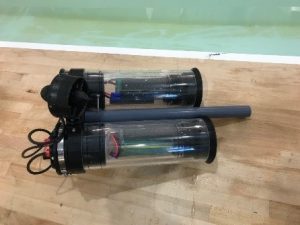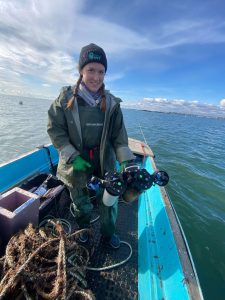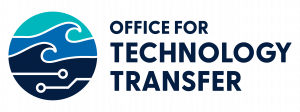Woods Hole Oceanographic Institution researchers are working to improve seaweed aquaculture scalability.
The fastest-growing aquaculture sector is seaweed farming. It can benefit marine ecosystems, farmers, and local communities by providing jobs and food, combatting ocean acidification’s local impacts, and even serving as an alternative fuel source. On a global scale, seaweed farms in the United States only generate a small percent of global output, and as demand continues to rise, overcoming the challenges of scaling seaweed production has become pertinent. Finding suitable growing environments, using effective seeding techniques, and establishing efficient harvesting methods are just some challenges in scaling seaweed cultivation. While there have been advancements in cultivating innovations, research and development are still needed to scale operations to meet demand efficiently.
From a faster way to conduct line seeding to new web tools for monitoring to breeding climate-resilient kelp strains, Woods Hole Oceanographic Institution (WHOI) researchers and engineers are creating solutions that could have a significant industry impact.
There has been increased interest in kelp farming in regions such as Maine and Alaska, where edible seaweed.

Kelp grown after four years of the team’s kelp breeding program
Photo credit: Jon Cohen
Growers are engaged in other seafood-related activities, such as fishing, lobstering, etc. However, currently, there is no consistent or reliable control of kelp seed supply and performance since kelp farming relies on wild-collected spores. As a result, some favored types of wild kelp have been overharvested, which can threaten their overall conservation. To support increasing demand, improved strains that can withstand warming oceans and not threaten wild kelp diversity are needed.
Over the last five years, WHOI Research Specialist Scott Lindell and fellow innovators Sergey Nuzhdin, Gary Molano, and Kelly DeWeese from the University of Southern California, along with Charles Yarish from the University of Connecticut have been working on selective kelp breeding aimed at increasing harvest yields.
Lindell and his team have successfully selectively bred kelp to exceed 15 kg/m – more than twice the average commercial farm yield. The team screens the kelp genome for natural mutations and then selects male and female parents to cross, producing non-reproductive offspring that cannot interbreed with or compete with native kelp. The Lindell Lab is also selecting warmer water-tolerant kelp to breed for greater resiliency to climate change, lengthen the overall growing season, and improve harvest yield.
As a result, the new kelp breeds cut the growing time required in nurseries, address regulatory concerns, & over time, lower the cost of production for established farms and provide an accessible starting point for new farms.
The Process for Improving Kelp Strains is currently patent pending.
WHOI researchers are also looking for opportunities to increase operational efficiency in the industry through automated line seeding. Research Engineer Robin Littlefield, Guest Investigator David Bailey, and Engineer Ben Weiss have developed the “Rapid Line-Seeder.” This battery-powered device automates kelp seeding by self-propelling down a growing line, reducing the amount of manual labor needed.

Rapid-Line Seeder
Using the Line-Seeder enables farmers to deploy seed-string to farm arrays without changing the farm structure. Due to the reduced exposure time in the air under freezing conditions, the team noted that the Rapid Line-Seeder could aid in lowering juvenile seaweed mortality rates. It would allow for larger weather windows for out-planting operations. By reducing the steps required for seeding, the Rapid Line-Seeder could help farms save time and money for the out-planting process.
The WHOI team has been working with collaborators at GreenWave, a global network

Maggie Aydlett – Kelp Seed Production Manager at GreenWave with the Rapid-Line Seeder
of regenerative ocean farmers, as well as with East Coast and Alaskan kelp growers, to evaluate the Rapid-Line Seeder’s potential to expedite the out-planting process, improve farming efficiency, and boost crop yield.
Both projects earned awards for seaweed solution projects at Seagriculture Conference USA 2022 in Portland, Maine. The Improved Kelp Strains received the Gold Innovation Award, and the Rapid Line-Seeder earned the Silver Innovation Award.
The success of offshore cultivation will require high-frequency monitoring to ensure viability. Remote sensing and autonomous vehicles have shown great promise in providing the necessary monitoring, but sufficient data is needed to understand kelp forest and farm trends for effective management.
The Rapid-Line Seeder is currently patent pending.
In addition, WHOI Assistant Scientist Tom Bell is investigating ways to make data more accessible to stakeholders in the industry. Through his work, Bell developed KelpWatch.org, a web tool providing visualization and analytic services to support the increased data required to make efficient decisions for kelp ecosystem management. Data outputs from KelpWatch.org can improve the accessibility of Landsat satellite data for researchers, management agencies, and even the public. Users can select a region, timeframe, and season and receive a summarized data set. Access to historical data trends can help stakeholders ensure the viability of kelp, even in offshore locations. Using satellite imagery and data mapping helps users understand kelp health and productivity in response to their environment. While KelpWatch.org largely focuses on natural kelp forests, the dynamics of aquaculture farms growing kelp species with a floating surface canopy will also be visible.
For more information on the Improved Kelp Strains, Rapid-Line Seeder, and/or KelpWatch.org, please contact:
WHOI’s Office for Technology Transfer
techtransfer@whoi.edu


